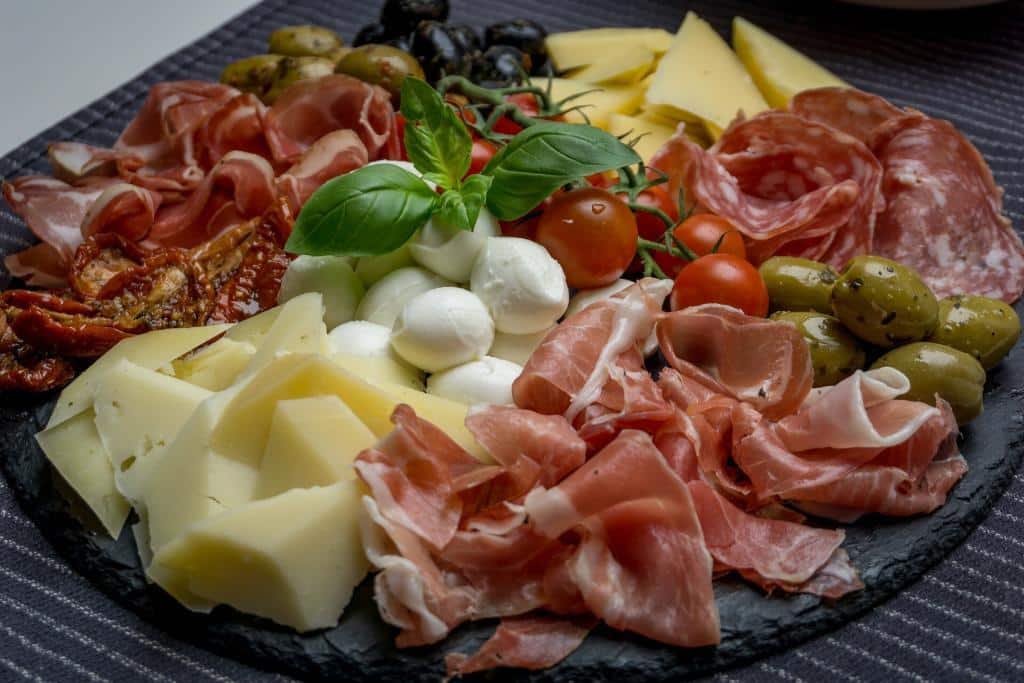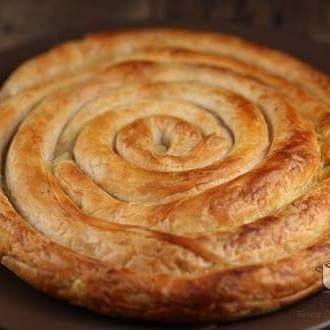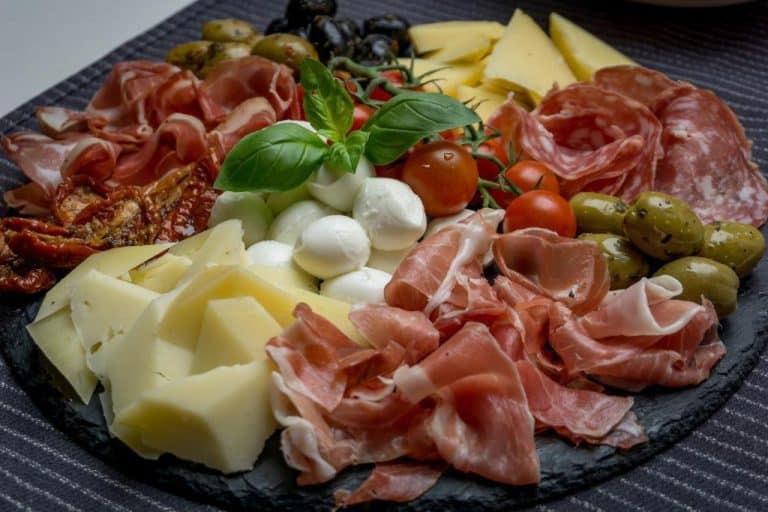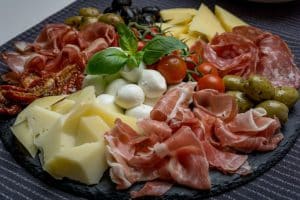Montenegro, located in southeastern Europe, offers a rich culinary heritage with various delicious local dishes.
Montenegrin’s cuisine reflects the country’s geographical location and cultural influences from neighboring countries.
If you visit this beautiful place soon, try these Montenegrin dishes at cafés and restaurants nationwide. Montenegro’s culinary scene offers a wealth of flavors that reflect the country’s diverse influences and local traditions.
Njeguški pršut (Njegusi prosciutto)

This is a famous Montenegrin dry-cured ham made from high-quality pork. It is traditionally smoked and aged in the Njegusi region, resulting in a distinctive flavor. It’s often served thinly sliced as an appetizer or in sandwiches.
Kačamak

Kačamak is a traditional cornmeal-based dish that resembles polenta. It is made by boiling cornmeal and mixing it with cheese (usually kajmak, a local dairy product) until it forms a thick, creamy consistency. It is typically served as a side dish with meat stews or as a main course.
Ćevapi

Although not originally from Montenegro, ćevapi is incredibly popular and commonly found throughout the country. These small, grilled sausages are made from minced meat (usually beef or lamb) and spices. They are typically served on a flatbread called lepinja, accompanied by onions and a side of kajmak.
Brav u mlijeku (Milk-Boiled Lamb)

This is a traditional Montenegrin dish consisting of lamb meat slowly cooked in milk until tender and flavorful. The lamb is typically seasoned with garlic, rosemary, and other herbs. It’s a dish often enjoyed during festive occasions and celebrations.
Riblja čorba (Fish Soup)

Given Montenegro’s coastal location, seafood plays a significant role in its cuisine. Riblja čorba is a famous fish soup made with various types of fish, such as carp, trout, or catfish. The soup is usually cooked with vegetables, herbs, and spices, resulting in a flavorful and hearty dish.
Priganice

Priganice are traditional Montenegrin fried dough balls. They resemble doughnuts made from flour, yeast, milk, and eggs. It is often served as a breakfast dish or a dessert, accompanied by honey, jam, or chocolate spread.
Sutlijaš

Sutlijaš is a rice pudding-like dessert that is widely enjoyed in Montenegro. It is made by cooking rice in milk with sugar and vanilla until it thickens. It can be served warm or chilled, sometimes garnished with ground cinnamon or chopped nuts.
Pita

Pita, or pie, is a staple in Montenegrin cuisine. There are various types of savory pies, such as cheese pie (sirnica), spinach pie (zeljanica), and meat pie (mesnica). Pita is made with thin layers of dough filled with the ingredients, then baked until golden and crispy.
Cicvara

Cicvara is a traditional Montenegrin dish made from cornmeal and is similar to polenta or kačamak. It is cooked with water and sometimes mixed with cheese or kajmak. It is a hearty and comforting dish, often served as a side dish with meat or as a main course.
Kotor-style seafood
Montenegro’s coastal areas, particularly Kotor, are renowned for their fresh seafood. Local specialties include grilled or baked fish such as sea bass, bream, or mullet, often seasoned with olive oil, garlic, and Mediterranean herbs. Black risotto, made with cuttlefish ink, is another popular seafood dish.
Uštipci

Uštipci is a small, deep-fried dough ball popular throughout the Balkans, including Montenegro. These savory treats are made from a simple dough mixture of flour, eggs, milk, and yeast. They are deep-fried until golden and served piping hot. It is versatile and can be enjoyed alone or paired with various toppings such as ajvar (a red pepper relish), kajmak, or sour cream.
Punjene Paprike

Punjene Paprike, also known as stuffed peppers, is a classic Montenegrin dish that showcases the region’s culinary heritage. Bell peppers are sealed with a flavorful mixture of ground meat, rice, onions, herbs, and spices. The peppers are baked until tender and served with a rich tomato sauce. This comforting and satisfying dish is a staple at family gatherings and special occasions.
Rožada

Rožada is a traditional Montenegrin dessert that is similar to crème brûlée. It is a creamy custard made with eggs, milk, and sugar and flavored with vanilla or lemon zest. The custard is gently baked until it sets and develops a caramelized top layer. It is often chilled and garnished with fresh fruits, such as berries or figs, adding a refreshing and tangy twist to the creamy dessert.
Pastrovski Makaruli
Pastrovski Makaruli is a signature dish originating from the pastoral region of Montenegro. This hearty pasta dish features thick, homemade noodles cooked al dente and tossed with a flavorful sauce made from a combination of ground meat (typically lamb or beef), onions, garlic, tomatoes, and aromatic herbs. The dish is an authentic comfort food showcasing the region’s rustic flavors and traditions.
Sopska Salad

Sopska Salad is a refreshing and colorful Montenegrin salad that has become a popular staple across the Balkans. The salad has a base of ripe tomatoes, crisp cucumbers, and bell peppers, all finely diced. It is then topped with generous amounts of crumbled white cheese, typically feta or a local variety. To enhance the flavors, the salad is drizzled with olive oil and sprinkled with herbs such as parsley or basil. It is a light and vibrant dish that beautifully captures the essence of Montenegrin summer cuisine.
Pogača

Pogača is a traditional Montenegrin bread that holds cultural significance. It is a round, crusty loaf made from a simple dough mixture of flour, yeast, salt, and water or milk. It is often adorned with decorative patterns on top and baked until golden and fragrant. This bread is a versatile accompaniment to various dishes, whether served plain or stuffed with cheese, spinach, or minced meat.
Kuvana Rakija
Kuvana Rakija is a warm and aromatic drink that is particularly popular during the winter months in Montenegro. It is made by infusing rakija (Montenegrin fruit brandy) with a blend of spices such as cloves, cinnamon, and citrus peels. The mixture is gently heated, allowing the flavors to meld together, creating a comforting and fragrant beverage. It is often enjoyed during festive gatherings and provides a cozy respite on chilly evenings.
Kolači

Kolači is a variety of traditional Montenegrin pastries and sweets, often served on special occasions, celebrations, or as a sweet indulgence. These bite-sized treats come in numerous shapes, flavors, and textures. Popular varieties include Priganice (small, fried doughnuts), Kiflice (crescent-shaped pastries filled with jam, cheese, or nuts), and Krofne (soft, filled doughnuts). It is a delightful way to experience the sweet side of Montenegrin culinary traditions.
Mantije

Mantije is a famous pastry dish with Turkish origins that has become a beloved part of Montenegrin cuisine. It consists of small pockets of dough filled with a savory mixture of ground meat, onions, and spices, often including a touch of cumin or paprika. The filled dough is then baked until golden and served hot. It is a delightful snack or appetizer, perfect for satisfying cravings for a savory bite.
Palačinke

Palačinke are thin and delicate pancakes that are a favorite dessert in Montenegro. Like French crêpes, these pancakes are made from a batter of flour, eggs, milk, and a hint of sugar. It is cooked on a griddle until lightly golden and can be filled with various sweet fillings such as Nutella, jam, fresh fruit, or whipped cream. They are rolled or folded into a compact shape and serve as a delightful treat for any time of day.
Pršut

It is prepared by salting and air-drying pork legs for an extended period, often several months. The result is a beautifully marbled and flavorful ham with a rich, salty taste. It is commonly served as an appetizer, thinly sliced and paired with cheese, olives, and fresh bread, or incorporated into various dishes for added depth of flavor.
Kačamak with Kajmak

Kačamak, or polenta, is a traditional cornmeal dish enjoyed throughout the Balkans. In Montenegro, it is often served with kajmak, a creamy dairy product similar to clotted cream. The dish is made by cooking coarse cornmeal with water and salt until it thickens into a porridge-like consistency. It is then served hot, topped with a generous dollop of kajmak, which adds a luscious and indulgent element to the dish.
Pita sa Sirom

Pita sa sirom, meaning “cheese pie,” is a beloved Montenegrin pastry that combines flaky layers of phyllo dough with a savory cheese filling. The filling is typically made from a mixture of local cheeses, such as feta or Njeguški sir, combined with eggs and herbs for added flavor. The pastry is baked until golden and crispy, resulting in a satisfying combination of textures and flavors. Pita sa sirom is a snack or part of a larger meal.
Riba na Žaru

Riba na žaru, or grilled fish, is a popular way to enjoy the flavors of the Adriatic Sea. Whole fish, such as sea bream, sea bass, or mackerel, are seasoned with herbs, lemon, and olive oil, then grilled to perfection. The result is tender, flaky fish with a smoky and charred exterior, showcasing the natural flavors of the sea.
Montenegro’s culinary traditions reflect the country’s cultural diversity and natural abundance. Exploring these local foods allows you to appreciate the unique flavors and culinary heritage that Montenegro has to offer. So, indulge in these delicious dishes during your visit, and let your taste buds take a delightful journey through Montenegrin cuisine.


